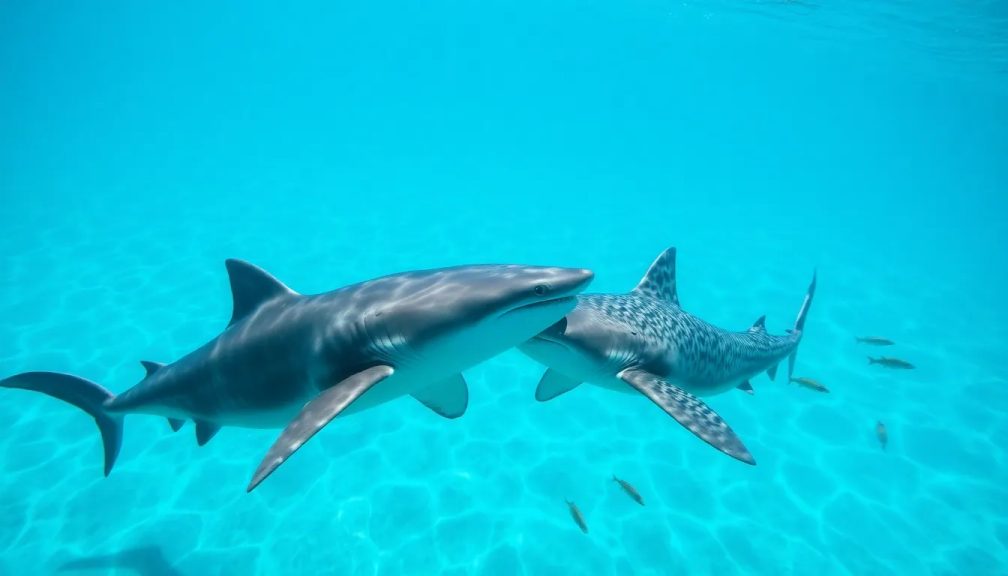Scientists capture rare shark mating behavior on camera

In a groundbreaking moment for marine biology, scientists have documented the first-ever recorded instance of leopard sharks engaging in a mating threesome. This unprecedented observation not only provides insight into the reproductive behaviors of these fascinating creatures but also raises important questions about genetic diversity and conservation strategies for the species. Let's dive into the details of this remarkable event.
Documenting a rare mating behavior
The remarkable footage was captured by marine biologist Eric Lassauce, who utilized two GoPro Hero 5 cameras to document the event. However, the situation was not without its challenges; Lassauce faced battery issues that resulted in two interruptions during the critical moments of the mating sequence. First, he received a "low battery" warning, prompting him to switch to the second camera. Then, he chose to conserve the remaining battery life by pausing filming, given that not much had occurred in the first 55 minutes. His decision ultimately paid off, as the footage would elicit cheers from his fellow researchers onboard, fully aware of the rarity of the mating behavior being recorded.
The mating ritual: A detailed sequence
The observed mating ritual lasted nearly an hour before any action took place. In the initial phase, all three sharks remained motionless on the seafloor, a behavior that is not uncommon among leopard sharks during the pre-copulation stage. Eventually, the female initiated movement, swimming with one male biting onto each of her pectoral fins. This led to a fascinating display of reproductive behavior:
- The first male shark penetrated the female's cloaca using his left clasper, which is a modified pelvic fin designed for sperm transfer.
- After completing his mating act, he remained motionless while the second male took his turn.
- The second male quickly followed suit, engaging in the same reproductive act.
- Following this, the female shark swam away, and the males soon departed as well.
This intricate mating sequence highlights not only the complexity of shark reproduction but also the specific behaviors that may be associated with mating strategies among species.
Significance for conservation efforts
The documentation of this mating behavior carries significant implications for leopard shark conservation. The site of this observation is potentially a critical mating habitat, which could lead to enhanced conservation strategies aimed at preserving these sharks. Christine Dudgeon, a co-author of the study from UniSC, expressed her excitement over the findings, noting, “It’s surprising and fascinating that two males were involved sequentially on this occasion.” The research team aims to gather more information regarding genetic diversity, specifically how many fathers contribute to the egg batches laid by females each year.
Understanding the mating patterns of leopard sharks could help in formulating strategies for artificial insemination aimed at "rewilding" populations of this species in Australia and beyond. The knowledge gained from these findings could be instrumental in ensuring the long-term survival of leopard sharks, which face threats from habitat loss and fishing pressures.
The broader implications of shark reproduction
Shark reproduction is a complex field of study that offers insights into the health of marine ecosystems. Recent studies have shown that understanding reproductive behaviors can reveal information about population dynamics, genetic diversity, and ecosystem health. For the leopard shark specifically, their unique reproductive strategies highlight the adaptability of species in the face of environmental changes.
Other factors that could influence reproduction include:
- Habitat conditions: The quality of the environment, including water temperature and availability of food sources.
- Predation: The presence of predators may impact the reproductive success of sharks.
- Human activity: Overfishing and habitat destruction can lead to decreased reproductive rates.
Continued research into these areas can help scientists develop more effective conservation measures, ensuring that these important species are protected for future generations.
Future research directions
The findings from this study provide a valuable foundation for future research. Scientists are eager to explore various aspects of leopard shark reproduction further, including:
- Genetic studies to determine the diversity of male contributions to offspring.
- Long-term monitoring of mating behaviors in other populations.
- Impact assessments of environmental changes on reproduction rates.
By focusing on these research areas, scientists hope to enhance conservation efforts and improve our understanding of the ecological roles that sharks play in marine environments.
For those interested in visual documentation of this historic moment, you can view a short video showcasing the mating event captured by researchers. This footage provides a unique perspective on the behaviors discussed:
As our understanding of marine biology evolves, each new discovery contributes to a more comprehensive picture of the delicate balance within ocean ecosystems. The documentation of the leopard shark threesome is just one example of the exciting findings that continue to emerge in this field.
In summary, the observation of leopard sharks mating offers a wealth of information regarding their reproductive behaviors and the implications for conservation initiatives. As scientists continue to study these fascinating creatures, we can look forward to more revelations that deepen our understanding of marine life.




Leave a Reply